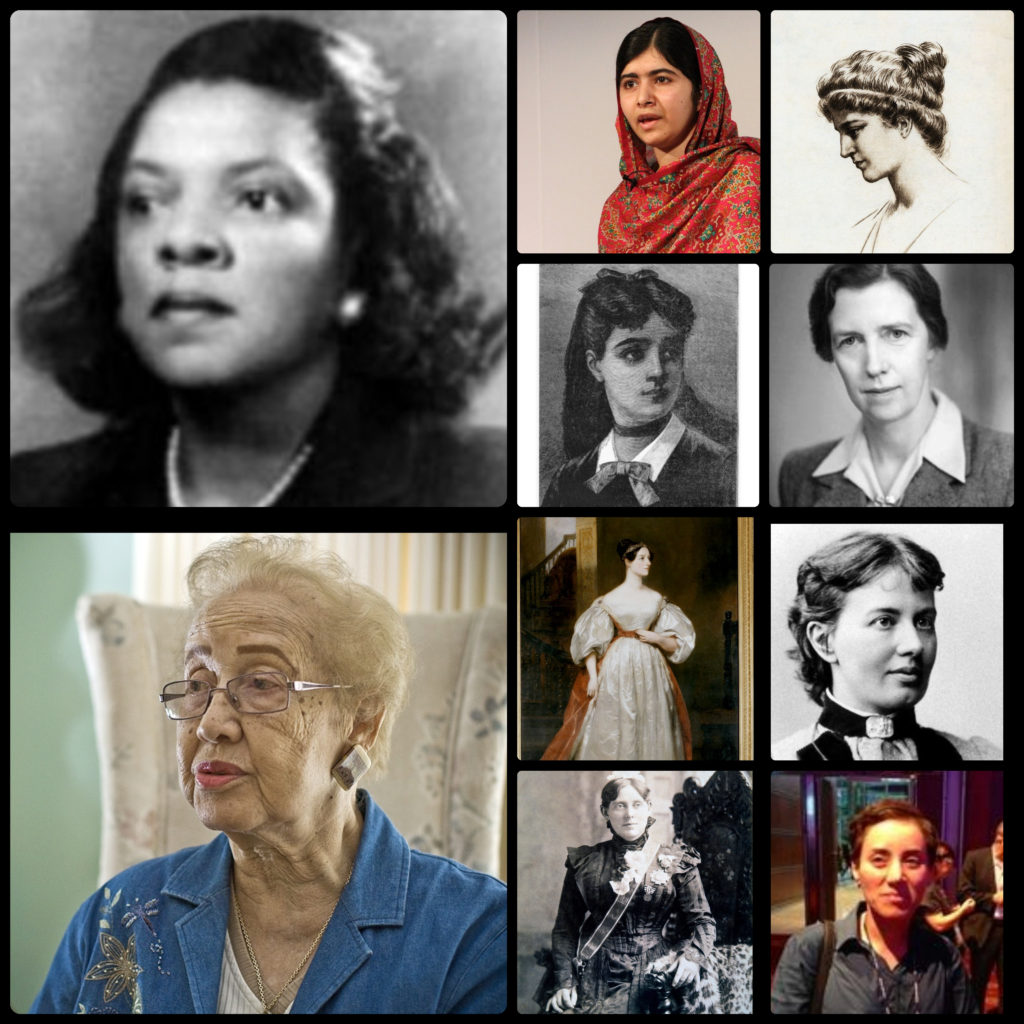
Math and many of the sciences seem to be traditionally male dominated professions. This doesn’t mean that only men have contributed to these fields. While researching female mathematicians in history, I came across more that I realized. So many so, one post is not sufficient. Below is a short list of notable female mathematicians throughout history. There are many more and another second short list of notable female mathematicians will follow. Below is a brief introduction to some of these mathematicians, in no particular order. While each received many awards and held important positions in the academic and mathematical community, their greatest impact was that they preserved in a predominantly male discipline helping to pave the way for the next generation of female mathematicians.
Maryam Mirzakhami (1977-2017) [1]
“The beauty of mathematics only shows itself to more patient followers.” [5]
Maryam is an Iranian born mathematician. She was a professor at Standford University. Her area of expertise within mathematics was the study of dynamics and Riemann surfaces. But what made her particularly memorable was that she was the first woman and Iranian to be awarded a Fields Medal. Unfortunately, she died just as she started becoming known for her contributions to mathematics.
Katherine Johnson (1918-2020) [1]
“Girls are capable of doing everything men are capable of doing. Sometimes they have more imagination than men.” [5]
Katherine was one of the first three black women to attend West Virginia University. She worked at NASA in 1953 ad was responsible for helping the first spaceship and the first Americans reach the moon with her calculations. In 2015 she was given the Presidential Medal of Freedom by Barack Obama for her work as a mathematician, physicist and space scientist as a woman of colour. She is one of the characters in the movie Hidden Figures (2016).
Dame Mary Lucy Cartwright (1900-1998) [1]
March Cartwright holds many “firsts” within mathematics. She was one of the first mathematicians to study chaos theory; first woman to receive a Sylvester Medal (award for mathematical research); first woman to be president of the mathematical association; first woman to be president of the London Mathematical Society.
Sofia Kovaleskaya (1850-1891) [1]
“It is impossible to be a mathematician without being a poet in soul.” [5]
Sofia was the first woman to obtain a doctorate in mathematics. She was awarded the Prix Bordin from the French Academy of Sciences, given to the best solution for a specific mathematical problem. The greatest impact from Sofia was that she never gave up on academia which paved the way for other females in mathematics.
Sophie Germain (1776-1831) [1]
“Algebra is but written geometry, and geometry is but figured algebra.” [5]
Poor Sophia faced opposition from society and parents due to her sex to study mathematics and physics. Despite not being able to attend university, she worked independently on her work in mathematics and physics. She was able to advance the field of number theory and is one of the pioneers of elasticity theory. She was the first woman to win the grand prize from the Paris Academy of Sciences for her essay on the subject of elasticity theory.
Marjorie Lee Browne (1914-1979) [1]
Marjorie Lee Browne was and African American mathematician and the first black woman to obtain a Phd in Mathematics. She taught for over 30 years at North Carolina Central University. She was appointed chair of the mathematics department in 1951. Through this position she paved the way for computer use in her field. She noted that there was a lack of involvement of black women in STEM subjects. She gained a grant to educate secondary school teachers in advanced maths spending a lot of her time with local secondary school teachers teaching them about linear algebra, encouraging them to obtain advanced degrees, improving the level of maths in North Carolina.
Malala Yousafzai ( 1997 – present)
“Education is neither eastern nor western. Education is education and it’s the right of every human being.” [1]
Malala is quite an impressive person. She is an activist for female education. She is the youngest person to win the Nobel Peace prize at 17. At 11 she started blogging for the BBC about her life under Taliban rule and her beliefs on the importance of education for girls. This was her foray into activism. Her connection to mathematics is when she took her A-Level Mathematics. She’s currently studying philosophy, politics and economics at Oxford University. Among her many awards she has been named one of Time Magazine’s 100 most influential people in the world. Malala doesn’t let anything stop her from her case, even an attempt on her life one day on her way to school. The United Nations noticed her story and went on to launch a campaign for education of all children worldwide. This help led Pakistan’s first Right to Education Bill. Through Malala we see education is a privilege.
Hypatia (ca 350 or 370-415 or 416) [2]
The first official female mathematician is unknown however Hyptaia I definitely one of the earliest. Her father was Theon, the last known member of the Library of Alexandria. She, like her father, studied mathematics and astronomy. She collaborated with her father on his critiques of mathematical works; translating them; incorporating explanatory notes; creating her own critiques; teaching students from her home. She was also a philosopher and spoke publicly about her ideas and beliefs to crowds of people. Unfortunately, her popularity was her downfall and was eventually kills by a mob of Christian zealots.
“There was a woman at Alexadria named Hypatia, daughter of the philosopher Theon, who made such attainments in literature and science, as to far surpass all the philosophers of her own time.” – Socrates Scholasticus, 5th century historian [5]
Ada Lovelace (1815-1852) [2]
“The more I study, the more insatiable do I feel my genius for it to be.” [5]
Ada Lovelace is the daughter of poet Lord Byron. Unfortunately, she never knew her father as he left England before her birth. Her mother encouraged her to study mathematics and science in the hopes she would grow up unemotional as possible. As and adult Ada corresponded with Charles Babbage who asked her to translate the Italian mathematical memoir analyzing his Analytical Engine. (This analytical engine is a machine that performed mathematical calculations programmed by punch cards, or one of the first computers.) Ada did more than just translate. She wrote her own notes about the machine and included instructions for calculating a sequence of Bernoulli numbers. This set of instructions is acknowledged as the world’s first computer program.
Florence Nightingale (1820-1910) [4]
Florence Nightingale was more than just a nurse in the Crimean War. While she did revolutionize nursing, she also developed her abilities with numbers and statistics. In order to present her case for better medical care to the UK government, she used statistics. She was one of the first to use circular diagrams as pictorial aids. She also invented a polar area graph, which is similar to a pie chart.
References
- 9 Famous Female Mathematicians Who have changed the world & What we can Learn from them, Ellie Williams, April 2020, Third Space Learning, URL: https://thirdspacelearning.com/blog/famous-female-mathematicians/
- Five Historic Female Mathematicians you should know, Sarah Zielinski, Oct 2011, Smithsonian, URL: https://www.smithsonianmag.com/science-nature/five-historic-female-mathematicians-you-should-know-100731927/?page=1
- 5 Trailblazing Female Mathematicians, Dave Roos, March 2019, how stuff works, URL: https://science.howstuffworks.com/math-concepts/5-trailblazing-female-mathematicians.htm
- 10 Female mathematicians who changed the world, Feb 2017, Kerry Kolbe, The Telegraph, URL: https://www.telegraph.co.uk/films/hidden-figures/female-mathematicians-who-changed-the-world/
- 10 Famous Women Mathematicians, March 2019, AU Online, Aurora University, URL: https://online.aurora.edu/infographics/10-famous-women-mathematicians/
- Five Famous female Mathematicians, maths careers, URL: https://www.mathscareers.org.uk/article/five-famous-female-mathematicians/
- Chronological Index of Women Mathematicians, Agnes Scott College, URL: https://www.agnesscott.edu/lriddle/women/chronol.htm
- Joan Clarke, woman who cracked Enigma cyphers with Alan Turing, Joe Miller, November 2014, BBC.com, URL: https://www.bbc.com/news/technology-29840653
- Joan Clarke, School History, URL: https://schoolhistory.co.uk/notes/joan-clarke/




